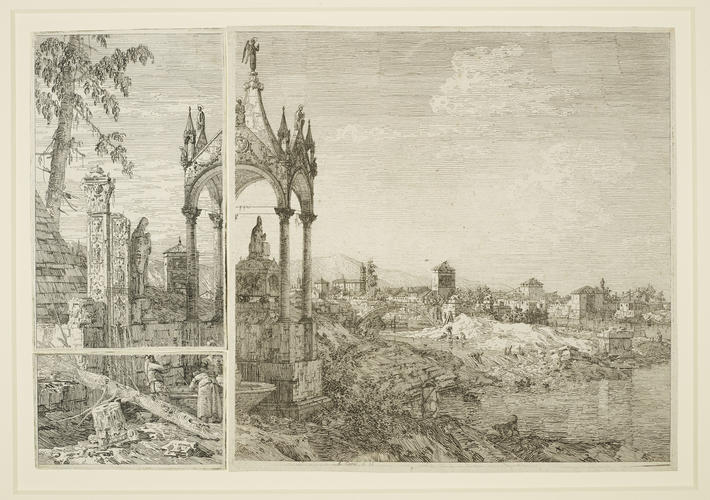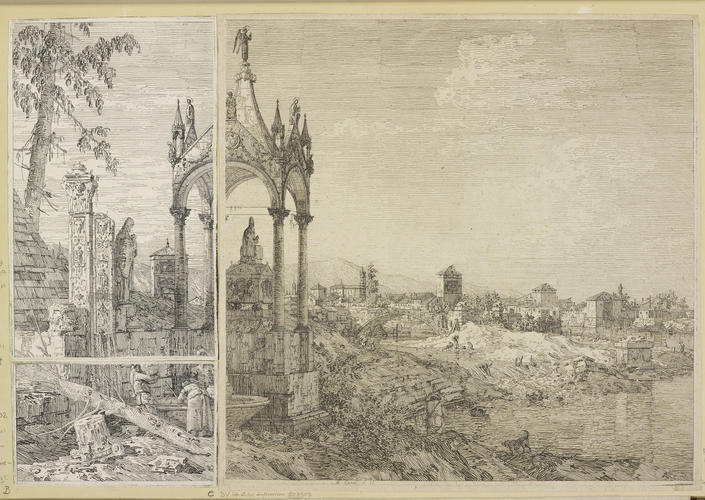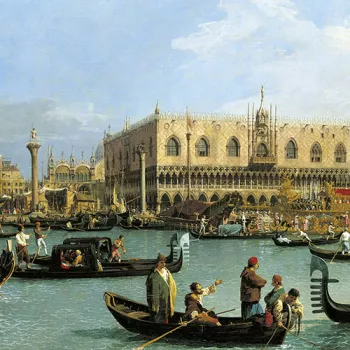'The Bishop's Tomb' c.1740-45
Etching | 22.0 x 13.3 cm (sheet of paper) | RCIN 807801

Canaletto (Venice 1697-Venice 1768)
'The Bishop's Tomb' c.1740-45

Canaletto (Venice 1697-Venice 1768)
'The Bishop's Tomb' c.1740-45

Canaletto (Venice 1697-Venice 1768)
'The Bishop's Tomb' c.1740-45




-
An etching of ruins and a tomb. On the left is part of a pyramid and tree. In the middle foreground are two square pillars decorated with carved grotesques. To their right is a statue of the Virgin Mary on a pedestal. On the right is part of a canopy which covers the tomb of a bishop. The canopy is surmounted by statues. Traces of gold paint around the edge of the sheet. This print was originally the upper left part of a larger plate, which was cut up into three parts. No impression of the larger composition is known. Bromberg 16 and 17 (RCINs 807802 and 807803) make up the other parts of the composition, with which this print is mounted. 807800 is a later impression.
Canaletto and his nephew Bernardo Bellotto began to experiment with etching in the early 1740s, an enterprise that has often been attributed to the decline in visitors to Venice and commissions following the War of Austrian Succession. Many of Canaletto's prints take their subject matter from the locks, sluice gates and summerhouses along the Brenta Canal towards Padua; others are entirely imaginary. Canaletto made just thirty-three etchings in total, etched on plates of two different sizes (about 30 x 42cm and 14 x 21cm), several prints include titles, but only one is dated, to 1741. Thirty-one of the prints were published together some time after 1744 as Vedute alle prese da i luoghi altre ideate (Views, some taken from nature, others imaginary). The titleplate is dedicated to ‘Signor Giuseppe Smith, Console di S. M. Britanico’, who was appointed to the position of Consul that year; the set was probably issued before the artist left for England in 1746. Smith possibly commissioned and financed Canaletto’s experiments. Many of the Canaletto etchings in the Print Room at Windsor are second and third states and were probably acquired in the twentieth century. Identifiable by the traces of gold from the wash line borders with which they were once surrounded in Smith's Canaletto album, only a handful of prints definitely belonged to Smith, including several rare and unique impressions, of which this is one.Provenance
Purchased by George III from Consul Joseph Smith, 1762
-
Creator(s)
Acquirer(s)
-
Medium and techniques
Etching
Measurements
22.0 x 13.3 cm (sheet of paper)
22.0 x 13.0 cm (platemark)
Category
Object type(s)








